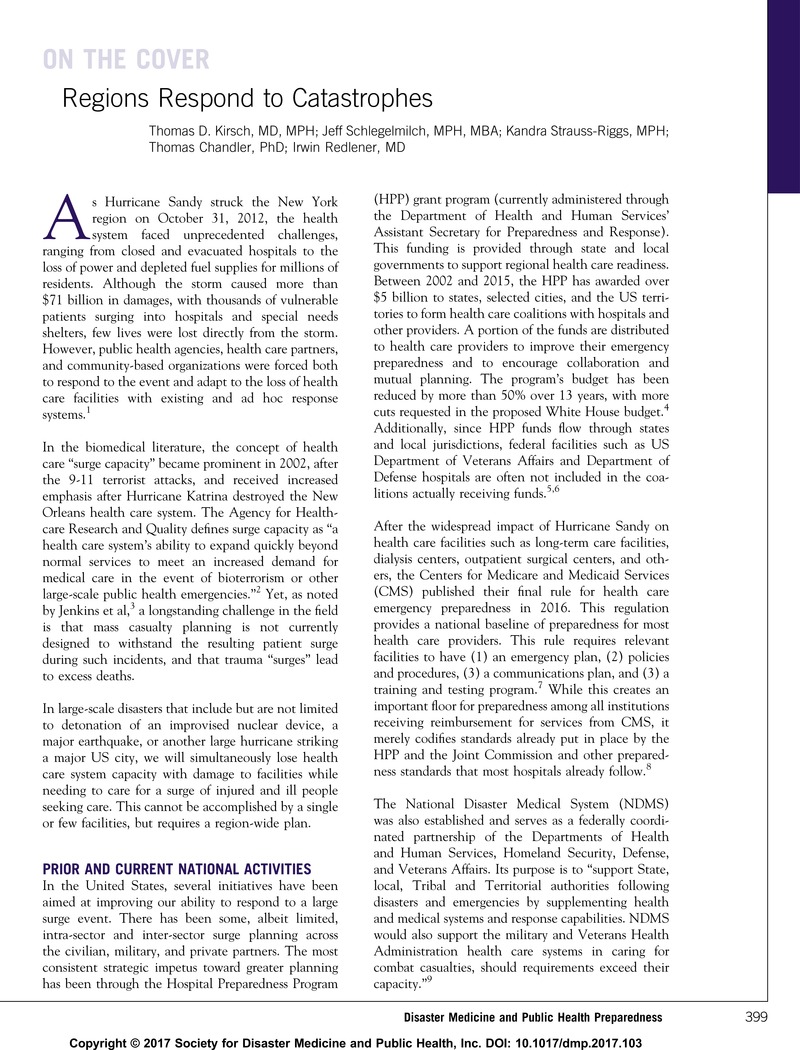No CrossRef data available.
Article contents
Regions Respond to Catastrophes
Published online by Cambridge University Press: 11 August 2017
Abstract
An abstract is not available for this content so a preview has been provided. Please use the Get access link above for information on how to access this content.

- Type
- On the Cover
- Information
- Disaster Medicine and Public Health Preparedness , Volume 11 , Issue 4 , August 2017 , pp. 399 - 401
- Copyright
- Copyright © Society for Disaster Medicine and Public Health, Inc. 2017
References
1.
Chandler, T, Abramson, DM, Panigrahi, B, et al. Crisis decision-making during Hurricane Sandy: an analysis of established and emergent disaster response behaviors in the New York metro area. Disaster Med Public Health Prep. 2016;10(3):436-442. https://doi.org/10.1017/dmp.2016.68.CrossRefGoogle Scholar
2. Agency for Health care Research and Quality. Bioterrorism and Health System Preparedness: Issue Briefs. AHRQ website. https://archive.ahrq.gov/news/ulp/btbriefs/. Published 2006. Accessed July 20, 2017.Google Scholar
3.
Jenkins, PC, Richardson, CR, Norton, EC, et al. Trauma surge index: advancing the measurement of trauma surges and their influence on mortality. J Am Coll Surg. 2015;221(3):729-738.e1. https://doi.org/10.1016/j.jamcollsurg.2015.05.016.CrossRefGoogle ScholarPubMed
4. White House. Budget for the U.S. Government. A New Foundation for America Greatness. https://www.whitehouse.gov/sites/whitehouse.gov/files/omb/budget/fy2018/budget.pdf. Accessed July 30, 2017.Google Scholar
5.
Schlegelmilch, J, Petkova, E, Redlener, I. Disaster prepared: how federal funding in the USA supports health system and public health readiness. J Bus Continuity Emerg Plann. 2015;9(2):112-118.Google Scholar
6.
Watson, C, Watson, M, Kirk Sell, T. Federal funding for health security in FY2018 [published online June 27, 2017]. Health Secur. doi: 10.1089/hs.2017.0047.Google Scholar
7. Centers for Medicare & Medicaid Services. Emergency Preparedness Rule. CMS.gov website. https://www.cms.gov/Medicare/Provider-Enrollment-and-Certification/SurveyCertEmergPrep/Emergency-Prep-Rule.html. Last updated June 20, 2017. Accessed July 20, 2017.Google Scholar
8.
YNHHS-CEPDR. CMS Emergency Preparedness Final Rule Crosswalk - Updated. New Haven, CT: Yale New Haven Health System Center for Emergency Preparedness and Disaster Response; 2017.Google Scholar
9.
US Department of Health and Human Services, Office of the Assistant Secretary for Preparedness and Response. National Disaster Medical System. Public Health Emergency website. https://www.phe.gov/Preparedness/responders/ndms/Pages/default.aspx. Last updated April 21, 2017. Accessed July 20, 2017.Google Scholar
10.
American Hospital Association. Trendwatch Chartbook 2016 - Trends Affecting Hospitals and Health Systems. AHA website. http://www.aha.org/research/reports/tw/chartbook/index.shtml. Published 2016. Accessed July 20, 2017.Google Scholar
11. Federation of American Hospitals and American Hospital Association. Estimating the impact of repealing the Affordable Care Act on hospitals. http://www.aha.org/content/16/impact-repeal-aca-report.pdf. Published 2016. Accessed July 17, 2016.Google Scholar


